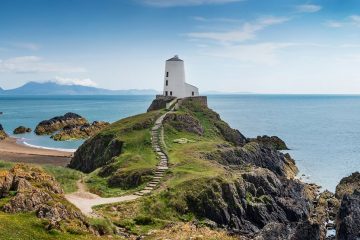Exploring the Magical Land of Wales
Wales is often the forgotten part of the United Kingdom, unfortunately missed by most travelers to this region of the world. Yet it hosts some of the most magnificent castles and castle ruins, picturesque beaches and scenic walks in all of Europe. It also has lush emerald hills so green they rival Ireland’s landscape, as well as a distinct Celtic culture.
Of course, with fewer people visiting, that means you may be able to explore some of its highlights practically all to yourself when you visit Wales, especially outside of the busier summer season.
Best Time to Visit Wales
While summer typically brings the best weather, with mild temperatures and a decreased chance for rain, it also means paying peak season rates and potentially battling some crowds. Though compared to popular destinations in Europe, hordes of tourists generally aren’t a concern.
If you’d like to enjoy the best of both worlds — lower airfare and reduced accommodation rates, along with a good chance for decent weather and fewer visitors — plan to visit during the shoulder season, from mid-May through mid-June, or from mid-September through mid-October.
What to Expect
Wales is sometimes described as being a mix between England and Ireland, but that really doesn’t give it enough credit for being a destination worthy of a visit on its own. Its coastline boasts some of the finest stretches of sand in the United Kingdom, and Gower’s Rhossili beach was even ranked one of the 10 best on the planet.
Wales has also been referred to as the “castle capital of the world,” and boasts jaw-dropping scenery that includes dramatic mountains and waterfalls in the North and stunning valleys in the South. Unlike England, Scotland or Northern Ireland, whose official language is English, Wales has its own distinct official language: Welsh.
Places to Visit in Wales
Snowdonia National Park
There are so many fantastic sights in Wales, you’d need to spend months or even years to see it all. But one of its must-experience destinations is Snowdonia National Park, home to 14 mountain peaks that are over 3,000 feet high, including Mount Snowdon, which can can be seen as far away as Porthmadog on the west coast.
Visitors can take the Snowdon Mountain Railway in the heart of the national park to reach its summit. Once there, it truly feels as if you’re on the top of the world. The park has miles and miles of hiking trails, and a long coastline with postcard-perfect sandy beaches and dramatic cliffs.
Castles
Visiting the country’s castles is really a must, including Conwy Castle, a medieval fortification on the north coast which stands as one of the greatest fortresses of medieval Europe, built by Edward I during his conquest of the country in the 13th century. Caernarfon Castle is one of Wales’ most famous, ranked as one of the best preserved, and most impressive in all of Europe.
Looming over the town of Caernarfon, its construction was ordered by Edward I following his defeat of the last native Welsh prince in the late 13th century. Displays and informative exhibitions throughout the towers reveal interesting tidbits about its history.
Tintern Abbey dates all the way back to the 12th century, and is even said to have inspired poems by Lord Tennyson and William Wordsworth. One of the country’s greatest monastic ruins, it’s incredibly impressive, surrounded by an area of outstanding natural beauty. This makes it a must-visit location in the U.K.
The remains of the building cover a four-century period between the early 12th and early 16th centuries.
Pembrokeshire Coast National Park
Pembrokeshire Coast National Park is the only coastal national park in the country, and is one of the most popular places for hiking. The Pembrokeshire Coast Path winds for nearly 200 miles along the cliffs that overlook the breathtakingly rugged shoreline. From here, seals can often be spotted sunning themselves on the rocks, while countless species of birds soar overhead.
Full of poignant messages and beautiful visuals, graffiti has become a draw for many travelers in recent years. These are the best cities for street art.
The Cost
Wales isn’t a cheap destination by any means, but these days, if you’re coming from the United States, you’ll find your dollar goes further than it once did thanks to a drop in the British pound. Prices are generally lower in Wales than in many parts of London, too.
With the combination of the current weak pound and somewhat lower prices, many foreign visitors will find the cost to be rather reasonable here.
Other Things You Should Know
No matter when you visit, you’re going to encounter rain. After all, there is a reason everything is so lush and green here. Don’t let it get in your way, though — learn to love it and come prepared with a hooded rain jacket.
As with Ireland, and the rest of the United Kingdom, you’ll be driving on the left in Wales. It can be challenging at times, especially in congested areas where cars are also parked on the left side as the streets are incredibly narrow. That means you may need to stop and wait for oncoming traffic to pass so you can drive around those parked cars.
You’ll grow used to it after a while, but you will need to be extra cautious. The street signs can also be exceptionally confusing, and simultaneously hilarious — you might find yourself wondering where all the vowels went to as you attempt to pronounce the words. Fortunately for outsiders, those signs are in both Welsh and English.
